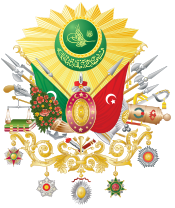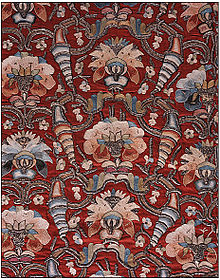- Ottoman dynasty
-
Ottoman Dynasty 
Country Ottoman Empire Titles Sultan
CaliphFounder Osman I Final sovereign Mehmed VI (Sultan)
Abdülmecid II (Caliph)Current head Bayezid Osman Founding 1299 Dissolution 1922 Deposition November 19th, 1922; Monarchy and Caliphate abolished, succeeded by Republic of Turkey State organisation of
the Ottoman Empire
 Ottoman Ceremonial Barbering Cape (detail), early 18th century, Turkey. Each day the sultan wore a different elaborately embroidered cape for his daily barbering. Public displays of extraordinary splendor were considered essential to the maintenance of Ottoman imperial authority. LACMA textile collection.
Ottoman Ceremonial Barbering Cape (detail), early 18th century, Turkey. Each day the sultan wore a different elaborately embroidered cape for his daily barbering. Public displays of extraordinary splendor were considered essential to the maintenance of Ottoman imperial authority. LACMA textile collection.
The Ottoman Dynasty (or the Imperial House of Osman) (Turkish: Osmanlı Hanedanı) ruled the Ottoman Empire from 1299 to 1922, beginning with Osman I (not counting his father, Ertuğrul), though the dynasty was not proclaimed until Orhan Bey[1] declared himself sultan. Before that the tribe/dynasty might have been known as Söğüt but was renamed Osmanlı (Ottoman in English) in honour of Osman.
The sultan was the sole and absolute regent, head of state and head of government of the empire, at least officially, though often much power shifted de facto to other officials, especially the Grand Vizier. See the article on state organisation of the Ottoman Empire for further information on the sultan and the structure of power.
Contents
Titles
The Ottoman dynasty is known in Turkish as Osmanlı, meaning "House of Osman". The first rulers of the dynasty never had called themselves sultans, but rather beys, or "chieftain", roughly the Turkic equivalent of Emir, which would itself become a gubernatorial title and even a common military or honorific rank. Thus they still formally acknowledged the sovereignty of the contemporary Seljuk Sultanate of Rûm and its successor, the Ilkhanate.
The first Ottoman to actually claim the title of sultân was Murad I, who ruled from 1359 to 1389. The title sultan (سلطان)—in Arabic, was in later Arabic-Islamic dynasties originally the power behind the throne of the Caliph in Bagdad and it was later used for various independent Muslim Monarchs. This title was more prestigious than Emir; it was not comparable to the title of Malik 'king' or the originally Persian title of Shah. With the Conquest of Constantinople in 1453, the road was open for the Ottoman state to become an empire, with Sultan Mehmed II taking the title of pâdişah (پادشاه), a Persian title meaning "lord of kings" claiming superiority to the other kings, that title was abandoned when the empire declined and lost its former might.
In addition to such secular titles, the Ottoman sultan became the Caliph of Islam, starting with Selim I, who became khalif after the death of the last Abbasid Caliph Al-Mutawakkil III, the last of Abbasid Caliphs in Cairo.
In Europe, Ottoman padishah was often referred to informally by such terms unrelated to the Ottoman protocol as the Grand Turk and the Grand Signor / Grand Signior.
The sultans further adopted in time many secondary formal titles as well, such as "Sovereign of the House of Osman", "Sultan of Sultans" (roughly King of Kings), and "Khan of Khans".
As the empire grew, sultans adopted secondary titles expressing the empire's claim to be the successor in law of the structures of the absorbed states. Furthermore they tended to enumerate even regular provinces, not unlike the long lists of -mainly inherited- feudal titles in the full style of many Christian European monarchs.
Some early Ottoman Sultans even had to accept the vassal status in the eyes of a foreign kingmaker. For example, Tamerlane appointed in 1402 the Ottoman Sultan (deposed in 1410) Sulayman Chelebi Khan, who was styled as-Sultan ul-Azam, Sayyid us-Saladin ul-Arab wal Ajam, Malik ur-Rikaab ul-Umam, Ghiyas ud-Daula wa ud-Dunya, Sultan ul-Islam was ul-Muslimin, as-Sultan ibni us-Sultan, Hasib-i-Nasib-I-Zaman, Amir of Rumelia. Again his brother, who ended the Interregnum after the defeat of Ottomans to Tamerlane, Mehmed I also held his post with a fief from Tamerlane. However the next Ottoman ruler (6th Sultan of House of Osman) was Sultan Murad Khan II (1421 - 1451) took the title 'Abu'l Hayrat, Sultan ul-Mujahidin, Khan of Khans, Grand Sultan of Anatolia and Rumelia, and of the Cities of Edirne and Filibe.
When Mehmed II conquered Constantinople on May 29, 1453, he claimed the title Emperor of the Roman Empire and protector of the Eastern Orthodox Church. He appointed the Patriarch of Constantinople Gennadius Scholarius, whom he protected and whose stature he elevated into leader of all the Eastern Orthodox Christians. As emperor of the Romans he laid claim to all Roman territories, which at the time before the Fall of Constantinople, however, extended to little more than the city itself, plus some areas in Morea (Peloponnese) and the Empire of Trebizond.
The conqueror of Constantinople was Sultan Mehmed II Fatih Ghazi 'Abu'l Fath (1451 - 1481, 7th Sovereign of the House of Osman), was still 'simply' styled Kaysar-i-Rum (=Emperor of [Byzantium = the second] Rome, Caesar of Rome), Khan of Khans, Grand Sultan of Anatolia and Rumelia, Emperor of the three Cities of Constantinople, Edirne and Bursa, Lord of the two lands and the two seas and the first to adopt the 'imperial' style Padishah.
Around 1500 the full style of naming of the ruling Sultan had become practically stabilised, e.g. in 1601 Sultan Mehmed III was called:
- Sultan Hân N.N.,
- Padishah,
- Hünkar,
- Hakan ül-Berreyn vel-Bahreyn;
- Sovereign of the House of Osman, Sultan of Sultans,
- Khan of Khans,
- Commander (Caliph) of the Faithful and Successor of the Prophet of the Lord of the Universe
- Custodian of the Holy Cities of Mecca, Medina and Jerusalem
- Caesar of the Roman Empire
- Emperor of The Three Cities of Constantinople, Adrianople and Bursa, and of the Cities of Damascus and Cairo, of all Azerbaijan, of the Magris, of Barka, of Kairouan, of Aleppo, of Arabic Iraq and of Acem, of Basra, of Al-Hasa, of Dilen, of Ar Raqqah, of Mosul, of Parthia, of Diyarbakır, of Cilicia, of the Vilayets of Erzurum, of Sivas, of Adana, of Karaman, Van, of Barbary, of Abyssinia, of Tunisia, of Tripoli, of Damascus, of Cyprus, of Rhodes, of Candia, of the Vilayet of the Morea, of the Marmara Sea, the Black Sea and also its coasts, of Anatolia, of Rumelia, Baghdad, Greece, Turkistan, Tartary, Circassia, of the two regions of Kabarda, of Georgia, of the plain of Kypchak, of the whole country of the Tartars, of Kefe and of all the neighboring countries, of Bosnia and its dependencies, of the City and Fort of Belgrade, of the Vilayet of Serbia, with all the castles, forts and cities, of all Albania, of all Eflak and Bogdania, as well as all the dependencies and borders, and many other countries and cities.
See also
- Ottoman Empire
- List of sultans of the Ottoman Empire
- Line of succession to the Ottoman throne
- Ottoman Emperors family tree
- Ottoman family tree (more detailed)
- Tuğra-Sultan's Signature
- List of Valide Sultans
- List of Ottoman Grand Viziers
- List of admirals in the Ottoman Empire
- List of Ottoman Kaptan Pashas
References
External links
- In English
- Website of the 700th Anniversary of the Ottoman Empire
- Official website of the immediate living descendants of the Ottoman Dynasty
- Turkey, includes all the full ruler styles with various biographical data in the Royal Ark
- Sultans, Contemporary Paintings by Ismail Acar
- Everything about Ottoman Empire Everything about the history, culture and civilization of Ottoman Empire
- MSN encarta - the Ottoman Empire (Archived 2009-11-01) (see Sultanate)
- WorldStatesmen- Turkey
- Ottoman Dynasty meet at Dolmabahçe Palace
- Ottoman Empire - The Family
- In Turkish
- In French
- interview with Neslişah Sultan on YouTube, granddaughter of the last emperor about her family's exile
— Imperial house —New Dynasty
Ruling house of the Ottoman Empire
1299 – 19 November 1922Vacant Preceded by
‘Abbāsid DynastyCaliphate Dynasty
1517 – 3 March 1924Ottoman Sultans / Caliphs Osman I · Orhan · Murad I · Bayezid I · Interregnum · Mehmed I · Murad II · Mehmed II · Murad II · Mehmed II · Bayezid II · Selim I · Suleiman I · Selim II · Murad III · Mehmed III · Ahmed I · Mustafa I · Osman II · Mustafa I · Murad IV · Ibrahim · Mehmed IV · Suleiman II · Ahmed II · Mustafa II · Ahmed III · Mahmud I · Osman III · Mustafa III · Abdülhamid I · Selim III · Mustafa IV · Mahmud II · Abdülmecid I · Abdülaziz · Murad V · Abdülhamid II · Mehmed V · Mehmed VI · Abdülmecid II (Caliph)Related Templates: Claimants · Valide SultansState organisation of the Ottoman Empire Central System
(Military administration)Government:Grand Vizier (list) · Viziers · Finance
Provincial System
(Civil administration)CentralMillets (Muslims (Sheikh ul-Islam) · Christians (Orthodox Patriarch · Armenian Patriarch · Syriac Orthodox) · Jews)LocalCategories:- Royal families
- Oghuz Turks
- 1281 establishments
- Ottoman dynasty
- Turkic dynasties
- European royal families
- Sultan Hân N.N.,
Wikimedia Foundation. 2010.
